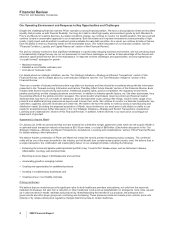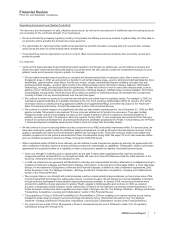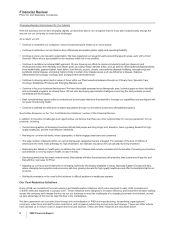Pfizer 2008 Annual Report Download - page 16
Download and view the complete annual report
Please find page 16 of the 2008 Pfizer annual report below. You can navigate through the pages in the report by either clicking on the pages listed below, or by using the keyword search tool below to find specific information within the annual report.
Financial Review
Pfizer Inc and Subsidiary Companies
Income: Tax Contingencies.) We consider many factors in making these assessments. Because litigation and other contingencies
are inherently unpredictable and excessive verdicts do occur, these assessments can involve a series of complex judgments about
future events and can rely heavily on estimates and assumptions (see Notes to Consolidated Financial Statements—Note 1C.
Significant Accounting Policies: Estimates and Assumptions).
Acquisitions
Our consolidated financial statements reflect an acquired business after the completion of the acquisition and are not restated. We
account for acquired businesses using the purchase method of accounting, which requires that most assets acquired and liabilities
assumed be recorded at the date of acquisition at their fair values. Any excess of the purchase price over the assigned values of the
net assets acquired is recorded as goodwill. Amounts allocated to acquired IPR&D have been expensed at the date of acquisition.
When we have acquired net assets that do not constitute a business under generally accepted accounting principles in the U.S.
(U.S. GAAP), no goodwill has been recognized.
The judgments made in determining the estimated fair value assigned to each class of assets acquired and liabilities assumed, as
well as asset lives, can materially impact our results of operations.
There are several methods that can be used to determine fair value. For intangible assets, including IPR&D, we typically use the
“income method.” This method starts with our forecast of all of the expected future net cash flows. These cash flows are then
adjusted to present value by applying an appropriate discount rate that reflects the risk factors associated with the cash flow
streams. Some of the more significant estimates and assumptions inherent in the income method or other methods include:
•the amount and timing of projected future cash flows;
•the amount and timing of projected costs to develop the IPR&D into commercially viable products;
•the discount rate selected to measure the risks inherent in the future cash flows; and
•the assessment of the asset’s life cycle and the competitive trends impacting the asset, including consideration of (i) any technical,
legal, regulatory, or economic barriers to entry, as well as (ii) expected changes in standards of practice for indications addressed by
the asset.
Determining the useful life of an intangible asset also requires judgment, as different types of intangible assets will have different
useful lives and certain assets may even be considered to have indefinite useful lives. For example, the useful life of the right to
patent associated with a pharmaceutical product’s exclusive patent will be finite and will result in amortization expense being
recorded in our results of operations over a determinable period. However, the useful life associated with a brand that has no patent
protection but that retains, and is expected to retain, a distinct market identity could be considered to be indefinite and the asset
would not be amortized.
Revenues
Revenue Recognition—We record revenues from product sales when the goods are shipped and title passes to the customer. At the
time of sale, we also record estimates for a variety of sales deductions, such as rebates, discounts and incentives, and product
returns. When we cannot reasonably estimate the amount of future product returns, we record revenues when the risk of product
return has been substantially eliminated.
Deductions from Revenues—Gross product sales are subject to a variety of deductions that are generally estimated and recorded in
the same period that the revenues are recognized, and primarily represent rebates and discounts to government agencies,
wholesalers, distributors and managed care organizations with respect to our pharmaceutical products. These deductions represent
estimates of the related obligations and, as such, judgment and knowledge of market conditions and practice are required when
estimating the impact of these sales deductions on gross sales for a reporting period.
Specifically,
•In the U.S., we record provisions for pharmaceutical Medicaid, Medicare and contract rebates based upon our experience ratio of
rebates paid and actual prescriptions written during prior quarters. We apply the experience ratio to the respective period’s sales to
determine the rebate accrual and related expense. This experience ratio is evaluated regularly to ensure that the historical trends are
as current as practicable. As appropriate, we will adjust the ratio to better match our current experience or our expected future
experience. In assessing this ratio, we consider current contract terms, such as changes in formulary status and discount rates. If our
ratio is not indicative of future experience, our results could be materially affected.
•Outside the U.S., the majority of our pharmaceutical rebates, discounts and price reductions are contractual or legislatively mandated,
and our estimates are based on actual invoiced sales within each period; both of these elements help to reduce the risk of variations in
the estimation process. Some European countries base their rebates on the government’s unbudgeted pharmaceutical spending and
we use an estimated allocation factor (based on historical payments) and total revenues by country against our actual invoiced sales to
project the expected level of reimbursement. We obtain third-party information that helps us monitor the adequacy of these accruals. If
our estimates are not indicative of actual unbudgeted spending, our results could be materially affected.
•Provisions for pharmaceutical chargebacks (primarily reimbursements to wholesalers for honoring contracted prices to third parties)
closely approximate actual as we settle these deductions generally within two to four weeks of incurring the liability.
•Provisions for pharmaceutical returns are based on a calculation in each market that incorporates the following, as appropriate: local
returns policies and practices; returns as a percentage of sales; an understanding of the reasons for past returns; estimated shelf-life by
product; and an estimate of the amount of time between shipment and return or lag time; and any other factors that could impact the
estimate of future returns, such as loss of exclusivity, product recalls, or a changing competitive environment, as appropriate.
14 2008 Financial Report
























